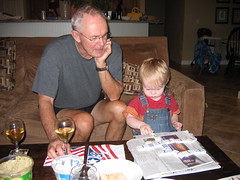A last word on Brats
Here is the final word on Brats, courtesy of the German Information Service. After this, it's back to grandchildren -- unless someone has something else to contribute to the blog!
"The brat’s American cousins
"Originally brought to the US by German Immigrants, the bratwurst has gone on to flourish in its new home, frequently seen at cook-outs alongside traditional hot dogs and hamburgers. In recent years, more specialty bratwursts are being offered by butchers and supermarkets alike. These boast creative fillings with different meats, including chicken, turkey or wild boar, as well as various vegetables, spices and cheeses.
"There are a number of festivals devoted to the German-style brat in the US. Some of the largest include the Bucyrus Bratwurst Festival in Ohio and two festivals in Wisconsin, Brat Days in Sheboygan and Brat Fest in Madison. These cities all compete for the right to call their city the Brat Capital of the US.
"Brat Days has been an annual event in Sheboygan, Wisconsin, since 1953, when it was initiated to mark the city’s 100th anniversary. The festival, which features a brat eating contest, live music and family activities, also serves as a fundraiser for the Sheboygan Jaycees who donate money to non-profit organizations in the community.
A couple of hours southwest, the city of Madison serves as the location for Brat Fest. Billed as the largest festival dedicated to the bratwurst, it grew rapidly from a one-man show in 1983 to the popular event it is now. The festival features live music and family fun while donating all of its proceeds to the local charities that help staff the event. According to their website, the festival holds a current world record with some 208,752 brats consumed between May 22 and 25, 2009.
"The Bucyrus Bratwurst Festival in Bucyrus, Ohio, which has been an annual event since 1968, attracts visitors from far and wide for their celebration of the bratwurst which features musical performances, parades, a beauty pageant, and a bike ride. This festival built on the long-standing tradition of the city’s butchers, who had been setting up stands outside their shops to sell their bratwursts to passers-by on summer evenings."
"The brat’s American cousins
"Originally brought to the US by German Immigrants, the bratwurst has gone on to flourish in its new home, frequently seen at cook-outs alongside traditional hot dogs and hamburgers. In recent years, more specialty bratwursts are being offered by butchers and supermarkets alike. These boast creative fillings with different meats, including chicken, turkey or wild boar, as well as various vegetables, spices and cheeses.
"There are a number of festivals devoted to the German-style brat in the US. Some of the largest include the Bucyrus Bratwurst Festival in Ohio and two festivals in Wisconsin, Brat Days in Sheboygan and Brat Fest in Madison. These cities all compete for the right to call their city the Brat Capital of the US.
"Brat Days has been an annual event in Sheboygan, Wisconsin, since 1953, when it was initiated to mark the city’s 100th anniversary. The festival, which features a brat eating contest, live music and family activities, also serves as a fundraiser for the Sheboygan Jaycees who donate money to non-profit organizations in the community.
A couple of hours southwest, the city of Madison serves as the location for Brat Fest. Billed as the largest festival dedicated to the bratwurst, it grew rapidly from a one-man show in 1983 to the popular event it is now. The festival features live music and family fun while donating all of its proceeds to the local charities that help staff the event. According to their website, the festival holds a current world record with some 208,752 brats consumed between May 22 and 25, 2009.
"The Bucyrus Bratwurst Festival in Bucyrus, Ohio, which has been an annual event since 1968, attracts visitors from far and wide for their celebration of the bratwurst which features musical performances, parades, a beauty pageant, and a bike ride. This festival built on the long-standing tradition of the city’s butchers, who had been setting up stands outside their shops to sell their bratwursts to passers-by on summer evenings."


